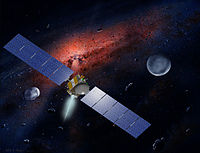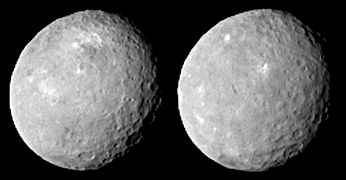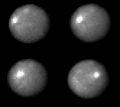From Wikipedia, the free encyclopedia
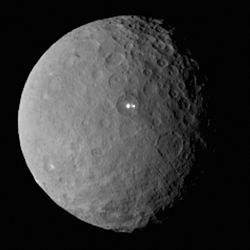
|
|||||||||
| Discovery[3] | |||||||||
|---|---|---|---|---|---|---|---|---|---|
| Discovered by | Giuseppe Piazzi | ||||||||
| Discovery date | 1 January 1801 | ||||||||
| Designations | |||||||||
| MPC designation | 1 Ceres | ||||||||
| Pronunciation | /ˈsɪəriːz/ | ||||||||
Named after
|
Cerēs | ||||||||
| A899 OF; 1943 XB | |||||||||
| dwarf planet main belt |
|||||||||
| Adjectives | Cererian /sɨˈrɪəri.ən/, rarely Cererean /sɛrɨˈriːən/[4] |
||||||||
| Orbital characteristics[6] | |||||||||
| Epoch 2014-Dec-09 (JD 2457000.5) |
|||||||||
| Aphelion | 2.9773 AU (445410000 km) |
||||||||
| Perihelion | 2.5577 AU (382620000 km) |
||||||||
| 2.7675 AU (414010000 km) |
|||||||||
| Eccentricity | 0.075823 | ||||||||
| 4.60 yr 1681.63 d |
|||||||||
| 466.6 d 1.278 yr |
|||||||||
Average orbital speed
|
17.905 km/s | ||||||||
| 95.9891° | |||||||||
| Inclination | 10.593° to ecliptic 9.20° to invariable plane[5] |
||||||||
| 80.3293° | |||||||||
| 72.5220° | |||||||||
| Satellites | None | ||||||||
| Proper orbital elements[7] | |||||||||
Proper semi-major axis
|
2.7670962 AU | ||||||||
Proper eccentricity
|
0.1161977 | ||||||||
Proper inclination
|
9.6474122° | ||||||||
Proper mean motion
|
78.193318 deg / yr | ||||||||
Proper orbital period
|
4.60397 yr (1681.601 d) |
||||||||
Precession of perihelion
|
54.070272 arcsec / yr | ||||||||
Precession of the ascending node
|
−59.170034 arcsec / yr | ||||||||
| Physical characteristics | |||||||||
Mean radius
|
476.2±1.7 km | ||||||||
Equatorial radius
|
487.3±1.8 km[8] | ||||||||
Polar radius
|
454.7±1.6 km[8] | ||||||||
| 2850000 km2 | |||||||||
| Mass | (9.43±0.07)×1020 kg,[9] 9.47±?[10] 0.00015 Earths 0.0128 Moons |
||||||||
Mean density
|
2.077±0.036 g/cm3,[8] 2.09±?[10] | ||||||||
| 0.28 m/s2[10] 0.029 g |
|||||||||
| 0.51 km/s[11] | |||||||||
Sidereal rotation period
|
0.3781 d 9.074170±0.000002 h[12] |
||||||||
| ≈ 3°[8] | |||||||||
North pole right ascension
|
19h 24m 291°[8] |
||||||||
North pole declination
|
59°[8] | ||||||||
| Albedo | 0.090±0.0033 (V-band geometric)[13] | ||||||||
|
|||||||||
Spectral type
|
C[14] | ||||||||
| 6.64[15] to 9.34[16] | |||||||||
| 3.36±0.02[13] | |||||||||
| 0.854″ to 0.339″ | |||||||||
Ceres /ˈsɪəriːz/[19] (minor-planet designation 1 Ceres) is the largest object in the asteroid belt, which lies between the orbits of Mars and Jupiter. It is composed of rock and ice, is 950 km (590 mi) in diameter, and contains approximately one third of the mass of the asteroid belt. It is the only dwarf planet in the inner Solar System. It was the first asteroid to be discovered, on 1 January 1801 by Giuseppe Piazzi in Palermo, though at first it was considered to be a planet. From Earth, the apparent magnitude of Ceres ranges from 6.7 to 9.3, and hence even at its brightest it is too dim to be seen with the naked eye except under extremely dark skies.
Ceres appears to be differentiated into a rocky core and icy mantle, and may harbor an internal ocean of liquid water under its surface. The surface is probably a mixture of water ice and various hydrated minerals such as carbonates and clay. In January 2014, emissions of water vapor were detected from several regions of Ceres.[20] This was somewhat unexpected, because large bodies in the asteroid belt do not typically emit vapor, a hallmark of comets.
The robotic Dawn spacecraft is scheduled to arrive at Ceres on 6 March 2015.[21] By January 2015 images had been taken with previously unattained resolution.
Discovery

Piazzi's book "Della scoperta del nuovo pianeta Cerere Ferdinandea" outlining the discovery of Ceres, dedicated the new "planet" to Ferdinand I of the Two Sicilies
Johann Elert Bode, in 1772, first suggested that an undiscovered planet could exist between the orbits of Mars and Jupiter.[22] Kepler had already noticed the gap between Mars and Jupiter in 1596.[22] Bode based his idea on the Titius–Bode law—a now-discredited hypothesis Johann Daniel Titius first proposed in 1766—observing that there was a regular pattern in the semi-major axes of the orbits of known planets, marred only by the large gap between Mars and Jupiter.[22][23] The pattern predicted that the missing planet ought to have an orbit with a semi-major axis near 2.8 astronomical units (AU).[23] William Herschel's discovery of Uranus in 1781[22] near the predicted distance for the next body beyond Saturn increased faith in the law of Titius and Bode, and in 1800, a group headed by Franz Xaver von Zach, editor of the Monatliche Correspondenz, sent requests to twenty-four experienced astronomers (dubbed the "celestial police"), asking that they combine their efforts and begin a methodical search for the expected planet.[22][23] Although they did not discover Ceres, they later found several large asteroids.[23]
One of the astronomers selected for the search was Giuseppe Piazzi at the Academy of Palermo, Sicily. Before receiving his invitation to join the group, Piazzi discovered Ceres on January 1, 1801.[24] He was searching for "the 87th [star] of the Catalogue of the Zodiacal stars of Mr la Caille", but found that "it was preceded by another".[22] Instead of a star, Piazzi had found a moving star-like object, which he first thought was a comet.[25] Piazzi observed Ceres a total of 24 times, the final time on 11 February 1801, when illness interrupted his observations. He announced his discovery on 24 January 1801 in letters to only two fellow astronomers, his compatriot Barnaba Oriani of Milan and Bode of Berlin.[26] He reported it as a comet but "since its movement is so slow and rather uniform, it has occurred to me several times that it might be something better than a comet".[22] In April, Piazzi sent his complete observations to Oriani, Bode, and Jérôme Lalande in Paris. The information was published in the September 1801 issue of the Monatliche Correspondenz.[25]
By this time, the apparent position of Ceres had changed (mostly due to Earth's orbital motion), and was too close to the Sun's glare for other astronomers to confirm Piazzi's observations. Toward the end of the year, Ceres should have been visible again, but after such a long time it was difficult to predict its exact position. To recover Ceres, Carl Friedrich Gauss, then 24 years old, developed an efficient method of orbit determination.[25] In only a few weeks, he predicted the path of Ceres and sent his results to von Zach. On December 31, 1801, von Zach and Heinrich W. M. Olbers found Ceres near the predicted position and thus recovered it.[25]
The early observers were only able to calculate the size of Ceres to within about an order of magnitude. Herschel underestimated its size as 260 km in 1802, whereas in 1811 Johann Hieronymus Schröter overestimated it as 2,613 km.[27][28]
Name
Piazzi originally suggested the name Cerere Ferdinandea for his discovery, after the goddess Ceres (Roman goddess of agriculture, Cerere in Italian) and King Ferdinand of Sicily.[22][25] "Ferdinandea", however, was not acceptable to other nations and was dropped. Ceres was called Hera for a short time in Germany.[29] In Greece, it is called Demeter (Δήμητρα), after the Greek equivalent of the Roman Cerēs;[a] in English, that name is used for the asteroid 1108 Demeter.The regular adjectival forms of the name are Cererian and Cererean,[30] derived from the Latin genitive Cereris,[4] but Ceresian is occasionally seen for the goddess (as in the sickle-shaped Ceresian Lake), as is the shorter form Cerean.
The old astronomical symbol of Ceres is a sickle, ⟨⚳⟩ (
The chemical element cerium, discovered in 1803, was named after Ceres.[33][b] In the same year another element was also initially named after Ceres, but when cerium was named its discoverer changed the name to palladium, after the second asteroid, 2 Pallas.[35]
Classification
The categorization of Ceres has changed more than once and has been the subject of some disagreement. Johann Elert Bode believed Ceres to be the "missing planet" he had proposed to exist between Mars and Jupiter, at a distance of 419 million km (2.8 AU) from the Sun.[22] Ceres was assigned a planetary symbol, and remained listed as a planet in astronomy books and tables (along with 2 Pallas, 3 Juno and 4 Vesta) for half a century.[22][25][36]
As other objects were discovered in the neighborhood of Ceres, it was realized that Ceres represented the first of a new class of objects.[22] In 1802, with the discovery of 2 Pallas, William Herschel coined the term asteroid ("star-like") for these bodies,[36] writing that "they resemble small stars so much as hardly to be distinguished from them, even by very good telescopes".[37] As the first such body to be discovered, Ceres was given the designation 1 Ceres under the modern system of asteroid numbering.[36]
The 2006 debate surrounding Pluto and what constitutes a 'planet' led to Ceres being considered for reclassification as a planet.[38][39] A proposal before the International Astronomical Union for the definition of a planet would have defined a planet as "a celestial body that (a) has sufficient mass for its self-gravity to overcome rigid-body forces so that it assumes a hydrostatic equilibrium (nearly round) shape, and (b) is in orbit around a star, and is neither a star nor a satellite of a planet".[40] Had this resolution been adopted, it would have made Ceres the fifth planet in order from the Sun.[41] This never happened, however, and on 24 August 2006 a modified definition was adopted, carrying the additional requirement that a planet must have "cleared the neighborhood around its orbit". By this definition, Ceres is not a planet because it does not dominate its orbit, sharing it as it does with the thousands of other asteroids in the asteroid belt and constituting only about a third of the mass of the belt. Bodies that met the first proposed definition but not the second, such as Ceres, were instead classified as dwarf planets.
It is sometimes assumed that Ceres has been reclassified as a dwarf planet, and that it is therefore no longer considered an asteroid. For example, a news update at Space.com spoke of "Pallas, the largest asteroid, and Ceres, the dwarf planet formerly classified as an asteroid",[42] whereas an IAU question-and-answer posting states, "Ceres is (or now we can say it was) the largest asteroid", though it then speaks of "other asteroids" crossing Ceres's path and otherwise implies that Ceres is still considered an asteroid.[43] The Minor Planet Center notes that such bodies may have dual designations.[44] The 2006 IAU decision that classified Ceres as a dwarf planet never addressed whether it is or is not an asteroid. Indeed, the IAU has never defined the word 'asteroid' at all, having preferred the term 'minor planet' until 2006, and preferring the terms 'small Solar System body' and 'dwarf planet' after 2006. Lang (2011) comments "the [IAU has] added a new designation to Ceres, classifying it as a dwarf planet. ... By [its] definition, Eris, Haumea, Makemake and Pluto, as well as the largest asteroid, 1 Ceres, are all dwarf planets", and describes it elsewhere as "the dwarf planet–asteroid 1 Ceres".[45] NASA continues to refer to Ceres as an asteroid, saying in a 2011 press announcement that "Dawn will orbit two of the largest asteroids in the Main Belt",[46] as do various academic textbooks.[47][48]
Physical characteristics
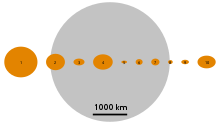
Sizes of the first ten main-belt objects discovered profiled against the Moon. Ceres is far left (1).
Ceres is the largest object in the asteroid belt.[14] The mass of Ceres has been determined by analysis of the influence it exerts on smaller asteroids. Results differ slightly between researchers.[49] The average of the three most precise values as of 2008 is 9.4×1020 kg.[9][49] With this mass Ceres comprises about a third of the estimated total 3.0 ± 0.2×1021 kg mass of the asteroid belt,[50] which is in turn about 4% of the mass of the Moon. The mass of Ceres is sufficient to give it a nearly spherical shape in hydrostatic equilibrium.[8] Among Solar System bodies, Ceres is intermediate in size between the smaller Orcus and 2002 MS4 and the larger Tethys. The surface area is approximately equal to the land area of India or Argentina.[51]
Internal structure
Ceres's oblateness is inconsistent with an undifferentiated body, which indicates that it consists of a rocky core overlain with an icy mantle.[8] This 100-kilometer-thick mantle (23%–28% of Ceres by mass; 50% by volume)[52] contains 200 million cubic kilometers of water, which is more than the amount of fresh water on Earth.[53] This result is supported by the observations made by the Keck telescope in 2002 and by evolutionary modeling.[9][54] Also, some characteristics of its surface and history (such as its distance from the Sun, which weakened solar radiation enough to allow some fairly low-freezing-point components to be incorporated during its formation), point to the presence of volatile materials in the interior of Ceres.[9]Alternatively, the shape and dimensions of Ceres may be explained by an interior that is porous and either partially differentiated or completely undifferentiated. The presence of a layer of rock on top of ice would be gravitationally unstable. If any of the rock deposits sank into a layer of differentiated ice, salt deposits would be formed. Such deposits have not been detected. Thus it is possible that Ceres does not contain a large ice shell, but was instead formed from low-density asteroids with an aqueous component. The decay of radioactive isotopes may not have produced sufficient heat to cause differentiation.[55]
Surface
The surface composition of Ceres is broadly similar to that of C-type asteroids.[14] Some differences do exist. The ubiquitous features of the Cererian IR spectra are those of hydrated materials, which indicate the presence of significant amounts of water in the interior. Other possible surface constituents include iron-rich clay minerals (cronstedtite) and carbonate minerals (dolomite and siderite), which are common minerals in carbonaceous chondrite meteorites.[14] The spectral features of carbonates and clay minerals are usually absent in the spectra of other C-type asteroids.[14] Sometimes Ceres is classified as a G-type asteroid.[56]
The Cererian surface is relatively warm. The maximum temperature with the Sun overhead was estimated from measurements to be 235 K (about −38 °C, −36 °F) on 5 May 1991.[18]
Prior to the Dawn mission, only a few Cererian surface features had been unambiguously detected. High-resolution ultraviolet Hubble Space Telescope images taken in 1995 showed a dark spot on its surface, which was nicknamed "Piazzi" in honor of the discoverer of Ceres.[56] This was thought to be a crater. Later near-infrared images with a higher resolution taken over a whole rotation with the Keck telescope using adaptive optics showed several bright and dark features moving with Ceres's rotation.[9][57] Two dark features had circular shapes and are presumably craters; one of them was observed to have a bright central region, whereas another was identified as the "Piazzi" feature.[9][57] More recent visible-light Hubble Space Telescope images of a full rotation taken in 2003 and 2004 showed 11 recognizable surface features, the natures of which are currently unknown.[13][58] One of these features corresponds to the "Piazzi" feature observed earlier.[13]
These last observations also determined that the north pole of Ceres points in the direction of right ascension 19 h 24 min (291°), declination +59°, in the constellation Draco. This means that Ceres's axial tilt is very small—about 3°.[8][13]
Atmosphere
There are indications that Ceres may have a tenuous atmosphere and water frost on the surface.[59] Surface water ice is unstable at distances less than 5 AU from the Sun,[60] so it is expected to sublime if it is exposed directly to solar radiation. Water ice can migrate from the deep layers of Ceres to the surface, but escapes in a very short time. As a result, it is difficult to detect water vaporization. Water escaping from polar regions of Ceres was possibly observed in the early 1990s but this has not been unambiguously demonstrated. It may be possible to detect escaping water from the surroundings of a fresh impact crater or from cracks in the subsurface layers of Ceres.[9] Ultraviolet observations by the IUE spacecraft detected statistically significant amounts of hydroxide ions near the Cererean north pole, which is a product of water-vapor dissociation by ultraviolet solar radiation.[59]In early 2014, using data from the Herschel Space Observatory, it was discovered that there are several localized (not more than 60 km in diameter) mid-latitude sources of water vapor on Ceres, which each give off about 1026 molecules (or 3 kg) of water per second.[61][62][c] Two potential source regions, designated Piazzi (123°E, 21°N) and Region A (231°E, 23°N), have been visualized in the near infrared as dark areas (Region A also has a bright center) by the W. M. Keck Observatory. Possible mechanisms for the vapor release are sublimation from about 0.6 km2 of exposed surface ice, or cryovolcanic eruptions resulting from radiogenic internal heat.[61] Surface sublimation would be expected to decline as Ceres recedes from the Sun in its eccentric orbit, whereas internally powered emissions should not be affected by orbital position. The limited data available are more consistent with cometary-style sublimation.[61] The spacecraft Dawn will arrive at Ceres in 2015 as it approaches aphelion, which may constrain its ability to observe this phenomenon.[61]
Potential for extraterrestrial life
Although not as actively discussed as a potential home for extraterrestrial life as Mars, Titan or Europa, the presence of water ice has led to speculation that life may exist there,[65][66][67] and that hypothesized ejecta could have come from Ceres to Earth.[68]Orbit
| Element type |
a (in AU) |
e | i | Period (in days) |
|---|---|---|---|---|
| Proper[7] | 2.7671 | 0.116198 | 9.647435 | 1681.60 |
| Osculating[6] (Epoch 2010-Jul-23) |
2.7653 | 0.079138 | 10.586821 | 1679.66 |
| Difference | 0.0018 | 0.03706 | 0.939386 | 1.94 |
Ceres follows an orbit between Mars and Jupiter, within the asteroid belt, with a period of 4.6 Earth years.[6] The orbit is moderately inclined (i = 10.6° compared to 7° for Mercury and 17° for Pluto) and moderately eccentric (e = 0.08 compared to 0.09 for Mars).[6]
The diagram illustrates the orbits of Ceres (blue) and several planets (white and gray). The segments of orbits below the ecliptic are plotted in darker colors, and the orange plus sign is the Sun's location. The top left diagram is a polar view that shows the location of Ceres in the gap between Mars and Jupiter. The top right is a close-up demonstrating the locations of the perihelia (q) and aphelia (Q) of Ceres and Mars. In this diagram (but not in general), the perihelion of Mars is on the opposite side of the Sun from those of Ceres and several of the large main-belt asteroids, including 2 Pallas and 10 Hygiea. The bottom diagram is a side view showing the inclination of the orbit of Ceres compared to the orbits of Mars and Jupiter.
Ceres was once thought to be a member of an asteroid family.[69] The asteroids of this family share similar proper orbital elements, which may indicate a common origin through an asteroid collision some time in the past. Ceres was later found to have spectral properties different from other members of the family, which is now called the Gefion family after the next-lowest-numbered family member, 1272 Gefion.[69] Ceres appears to be merely an interloper in the Gefion family, coincidentally having similar orbital elements but not a common origin.[70]
The rotational period of Ceres (the Cererian day) is 9 hours and 4 minutes.[71]
Ceres is in a near-1:1 mean-motion orbital resonance with Pallas (their orbital periods differ by 0.3%).[72] However, a true resonance between the two would be unlikely; due to their small masses relative to their large separations, such relationships among asteroids are very rare.[73]
Transits of planets from Ceres
Mercury, Venus, Earth, and Mars can all appear to cross the Sun, or transit it, from a vantage point at Ceres. The most common transits are those of Mercury, which usually happen every few years, most recently in 2006 and 2010. The most recent transit of Venus was in 1953, and the next will be in 2051; the corresponding dates are 1814 and 2081 for Earth, and 767 and 2684 for Mars.[74]Occultations
On December 22, 2012, Ceres occulted the star TYC 1865-00446-1 over parts of Japan, Russia, and China.[75] Ceres's brightness was magnitude 6.9 and the star, 12.2.[75]Origin and evolution
Ceres is probably a surviving protoplanet (planetary embryo), which formed 4.57 billion years ago in the asteroid belt.[54] Although the majority of inner Solar System protoplanets (including all lunar- to Mars-sized bodies) either merged with other protoplanets to form terrestrial planets or were ejected from the Solar System by Jupiter,[76] Ceres is believed to have survived relatively intact.[54] An alternative theory proposes that Ceres formed in the Kuiper belt and later migrated to the asteroid belt.[77] Another possible protoplanet, Vesta, is less than half the size of Ceres; it suffered a major impact after solidifying, losing ~1% of its mass.[78]The geological evolution of Ceres was dependent on the heat sources available during and after its formation: friction from planetesimal accretion, and decay of various radionuclides (possibly including short-lived elements like 26Al). These are thought to have been sufficient to allow Ceres to differentiate into a rocky core and icy mantle soon after its formation.[13][54] This process may have caused resurfacing by water volcanism and tectonics, erasing older geological features.[54] Due to its small size, Ceres would have cooled early in its existence, causing all geological resurfacing processes to cease.[54][79] Any ice on the surface would have gradually sublimated, leaving behind various hydrated minerals like clay minerals and carbonates.[14]
Today, Ceres appears to be a geologically inactive body, with a surface sculpted only by impacts.[13] The presence of significant amounts of water ice in its composition[8] raises the possibility that Ceres has or had a layer of liquid water in its interior.[54][79] This hypothetical layer is often called an ocean.[14] If such a layer of liquid water exists, it is believed to be located between the rocky core and ice mantle like that of the theorized ocean on Europa.[54] The existence of an ocean is more likely if solutes (i.e. salts), ammonia, sulfuric acid or other antifreeze compounds are dissolved in the water.[54]
When Ceres has an opposition near the perihelion, it can reach a visual magnitude of +6.7.[15] This is generally regarded as too dim to be seen with the naked eye, but under exceptional viewing conditions a very sharp-sighted person may be able to see this dwarf planet. Ceres was at its brightest (6.73) on December 18, 2012.[16] The only other asteroids that can reach a similarly bright magnitude are 4 Vesta, and, during rare oppositions near perihelion, 2 Pallas and 7 Iris.[80] At a conjunction Ceres has a magnitude of around +9.3, which corresponds to the faintest objects visible with 10×50 binoculars. It can thus be seen with binoculars whenever it is above the horizon of a fully dark sky.
Some notable observational milestones for Ceres include:
- An occultation of a star by Ceres observed in Mexico, Florida and across the Caribbean on November 13, 1984.[81]
- Ultraviolet Hubble Space Telescope images with 50 km resolution taken on June 25, 1995.[56][82]
- Infrared images with 30 km resolution taken with the Keck telescope in 2002 using adaptive optics.[57]
- Visible light images with 30 km resolution (the best to date) taken using Hubble in 2003 and 2004.[13][58]
- In 2014, Ceres was found to have an atmosphere with water vapor, confirmed by the Herschel space telescope.[83]
Exploration
In 1981, a proposal for an asteroid mission was submitted to the European Space Agency (ESA). Named the Asteroidal Gravity Optical and Radar Analysis (AGORA), this spacecraft was to launch some time in 1990–1994 and perform two flybys of large asteroids. The preferred target for this mission was Vesta. AGORA would reach the asteroid belt either by a gravitational slingshot trajectory past Mars or by means of a small ion engine. However, the proposal was refused by ESA. A joint NASA–ESA asteroid mission was then drawn up for a Multiple Asteroid Orbiter with Solar Electric Propulsion (MAOSEP), with one of the mission profiles including an orbit of Vesta. NASA indicated they were not interested in an asteroid mission. Instead, ESA set up a technological study of a spacecraft with an ion drive. Other missions to the asteroid belt were proposed in the 1980s by France, Germany, Italy, and the United States, but none were approved.[84] Exploration of Ceres by fly-by and impacting penetrator was the second main target of the second plan of the multiaimed Soviet Vesta mission, developed in cooperation with European countries for realisation in 1991–1994 but canceled due to the Soviet Union disbanding.
In the early 1990s, NASA initiated the Discovery Program, which was intended to be a series of low-cost scientific missions. In 1996, the program's study team recommended as a high priority a mission to explore the asteroid belt using a spacecraft with an ion engine. Funding for this program remained problematic for several years, but by 2004 the Dawn vehicle had passed its critical design review.[85]
It was launched on 27 September 2007, as the first space mission to Ceres. On 3 May 2011, Dawn acquired its first targeting image 1.2 million kilometers from Vesta.[86] After orbiting Vesta for 13 months, Dawn used its ion engine to depart for Ceres, with orbital insertion planned on 6 March 2015,[87] four months prior to the New Horizons flyby of Pluto.
Dawn's mission profile calls for it to enter orbit around Ceres at an altitude of 5,900 km. The spacecraft will reduce its orbital distance to 1,300 km after five months of study, and then down to 700 km after another five months.[88] The spacecraft instrumentation includes a framing camera, a visual and infrared spectrometer, and a gamma-ray and neutron detector. These instruments will examine Ceres's shape and elemental composition.[89] On January 13, 2015, Dawn took the first images of Ceres at near-Hubble resolution, revealing at least 2 impact craters, along with a small high-albedo location on the surface, near the same location as that observed by previous observations. Additional photo sessions, at increasingly better resolution took place on January 25, February 4, February 12, and February 19. Four more are planned (February 25, March 1, April 10 and 15) as Dawn approaches Ceres before full observation begins with orbital capture.[90]
The Chinese Space Agency is designing a sample retrieval mission from Ceres that would take place during the 2020s.[91]
Gallery
Ceres from Dawn, 47,000
kilometers (29,000 mi) away.
At this distance, Ceres is about
the apparent size of the full
moon (19 February 2015). The
large basin in the lower portion
of the left image appears
relatively young.[93]
kilometers (29,000 mi) away.
At this distance, Ceres is about
the apparent size of the full
moon (19 February 2015). The
large basin in the lower portion
of the left image appears
relatively young.[93]
Ceres at 84,000 kilometers
(52,000 mi) away (12 February
2015), at half the apparent size
of the full moon. Relative to
these images, those at left were
taken at similar longitudes but a
more northerly latitude,[92] and
are rotated about 45° clockwise.
(52,000 mi) away (12 February
2015), at half the apparent size
of the full moon. Relative to
these images, those at left were
taken at similar longitudes but a
more northerly latitude,[92] and
are rotated about 45° clockwise.
-
Color image of Ceres from the Hubble Space Telescope (HST) in 2004
-
HST images taken over a 2 hour, 20 minute span (2004)



